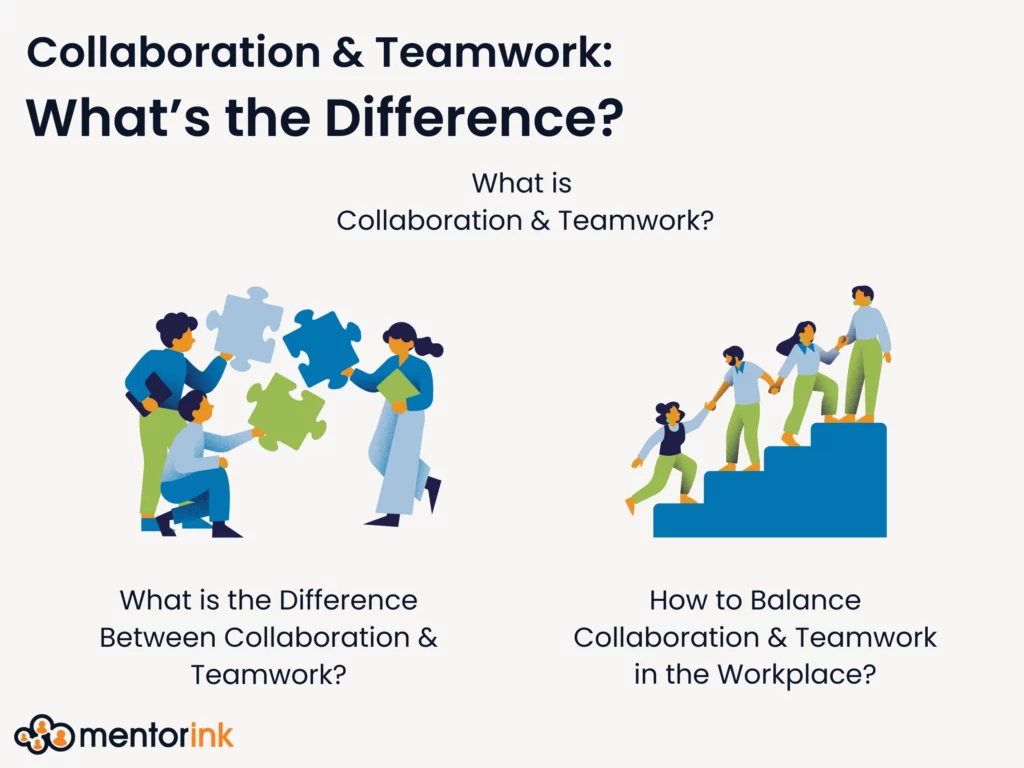
Nowadays, many people often use the words “collaboration” and “teamwork” to mean the same thing in today’s fast-paced workplace. Both are necessary for an active workplace, yet they mean different things and serve different purposes. To create a workplace culture where both collaboration and teamwork are used successfully to reach organizational goals, it is important to know the difference between the collaboration & teamwork.
In order to sustain collaboration & teamwork in the workplace, you may need mentorship activities to boost organization of the team. Our blog content about “How Mentorship Can Help Organizations Increase Workplace Productivity” can give you detailed information.
What is Collaboration & Teamwork?
When people work as a team, they usually have clear roles and responsibilities and work together to reach a shared goal. People on a team rely on each other’s skills and work to finish tasks, which are usually done in a structured way. Everyone on the team should know what they’re supposed to do, and the group’s success will depend on how well they work together.
Collaboration, on the other hand, is when people with different skills and points of view work together to make something new or figure out a tough problem. Collaboration can be seen as more flexible than teamwork, where roles may be set in stone. This typically involves coming up with new ideas together, sharing them, and combining different types of knowledge to create something new. People can play more than one part in a collaborative setting, and their contributions are often more dynamic, which shows how powerful synergy can be.
To show the difference between collaboration & teamwork, think about how doctors, nurses, and support staff might work together in a hospital to treat patients, with each person having their own job to do. As an alternative, collaboration might result in the same group of people coming up with new ideas for a treatment plan or a new way to care for patients. Depending on the situation, working together can mean anything from making art to fixing problems.
How to Balance Collaboration & Teamwork in the Workplace?
Finding the right balance between collaboration and teamwork at work is essential for both output and new ideas. When you esteem teamwork at work, you create an organized space where tasks are clear and processes run smoothly.
But depending only on teamwork can sometimes make it harder to be creative and flexible. Collaboration, on the other hand, leads to new ideas, freedom, and problem-solving, but it might need more adaptability in how things are set up and how decisions are made.
To keep things in balance, businesses should figure out when teamwork is needed and when cooperation should be the main focus. Teamwork is great for doing the same things over and over, making deadlines, and running a business efficiently.
Collaboration, on the other hand, is ideal when you need to come up with new ideas, solve problems, and be creative. It will be more dynamic and productive at work if employees are encouraged to switch between these two ways of doing things based on the task.
For example, an organization might require structured teamwork for day-to-day tasks but encourage cooperation during strategy meetings, brainstorming sessions, and new project work. The important thing is to create a workplace that knows both are needed and lets workers switch between them as needed.
What is the Difference Between Collaboration & Teamwork?
Is collaboration the same as teamwork? No, collaboration is more open-ended, while teamwork tends to be more task-oriented. While teamwork is about following an established path, collaboration is about charting new territory. For example, teamwork might involve a marketing team executing a planned advertising campaign, while collaboration could involve brainstorming new product ideas that disrupt the market.
One of the primary differentiators between collaboration and teamwork is the structure. Teamwork typically employs a hierarchical structure, with each team member assigned a specific role and following defined processes to achieve a collective goal. In contrast, collaboration is typically more flexible and spontaneous, with a focus on sharing diverse perspectives and ideas to create new solutions or address problems.
Another key difference is the focus. In teamwork, the emphasis is often on achieving a shared goal, such as completing a project or meeting a deadline, with each team member contributing to a specific aspect of the work.
In a collaborative environment, the focus shifts more toward innovation and creativity. Team members are encouraged to think outside the box, challenge ideas, and build on one another’s insights to come up with novel solutions.
Finally, the degree of autonomy varies. In a team environment, individual contributions are often dependent on the efforts of their teammates to achieve a successful outcome. Team members are frequently interdependent, and the team’s success hinges on the effectiveness of each individual in fulfilling their role.
In a collaborative environment, individuals may work with greater autonomy, offering distinctive insights or expertise without necessarily relying on others to complete their assigned tasks. What distinguishes collaboration from teamwork? It is more oriented towards collective problem-solving than following predefined roles.


